… Like the Yucca Mountain nuclear waste repository, the Svalbard Global Seed Vault is also built deep inside of a mountain. Unlike Yucca Mountain, the Vault, which is the world’s largest seed bank, is conceived of as a boon to, not a burden on, future generations. Located near Longyearbyen, Norway, on Spitsbergen Island in the remote Svalbard archipelago, the Vault is some six hundred miles from the north pole. On February 26, 2008, the day of its inauguration, the Vault received shipments of 100 million seeds, “backups” of the planet’s extant food-crop seeds, which are now enclosed in a structure designed to withstand nuclear bombs and global warming. Its back wall, for instance, is concave, in order to repel and rebound projectile weapons. By contrast, the Vault’s facade, bejeweled with an artwork called Perpetual Repercussion by the Norwegian artist Dyveke Sanne, is an inviting beacon, a gemlike installation that visually performs the Vault’s multidimensional implications while vigorously signaling its location with steel, mirrors, and prisms cut into triangles of various sizes. The triangular segments reflect the midnight sun in the summer months: during the four-month polar night, a network of fiber-optic cables casts turquoise and white lights, which reflect between the mirrors.
… For Dyveke Sanne, the Vault’s importance lies less in the seeds it contains than in the reflections and actions its very presence ought to provoke. On a couple of occasions in July 2008, Dyveke and I talked over homemade sourdough bread at her house and studio outside of Asker, in southeastern Norway, where she lives with several sociable goats and chickens along with her husband, Jeremy, an architect, and Alma, their fourteen-year-old daughter, an aspiring veterinarian. (I learned from Alma about cancer-sniffing dogs, mine-sweeping rats—the rats are light enough not to set off the mines—and bomb-sniffing bumblebees. That doesn’t work so well, Alma explained, since bees live only six weeks and it takes two weeks to train them.)
Dyveke Sanne grew up in the countryside north of Lillehammer and later in Oslo. She has lived in Spain, France, Canada, Germany, and New York. Sanne’s conceptual sculptures explore optics and cognition, the mechanics and metaphysics of the elusive glimpse, and the oscillations of awareness withal. Regarding the Vault, she remarked that it is “the gift that no one wants.” It is indeed a difficult gift, which Sanne has duly wrapped in complex light.
—Miranda Mellis
I. “THE SUN NEVER RISES.”
THE BELIEVER: How did you get involved with the Svalbard Global Seed Vault?
DYVEKE SANNE: Something with prisms was desirable for the entranceway. Since I’ve worked with mirrors, prisms, lights, and reflections in different ways, I got this commission through the KORO office [Public Art...
You have reached your article limit
Sign up for a digital subscription and continue reading all new issues, plus our entire archives, for just $1.50/month.
Already a subscriber? Sign in





